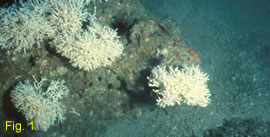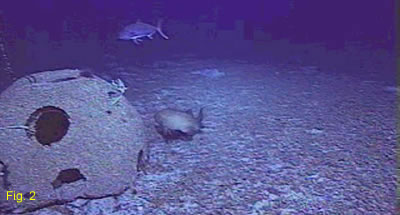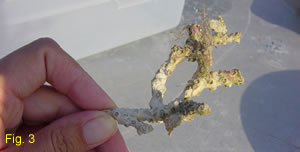May 6, 03
Species Boundaries in Oculina corals
by Margaret Miller, NOAA-Fisheries 
The coral
species which constitutes the Oculina banks goes by the name Oculina
varicosa (fig 1). Over the past few years,
continued decline of the OHAPC O.varicosa population has been observed
and virtually no new recruitment of new colonies has been observed
on artificial restoration structures (fig 2),
despite the stringent habitat protections that are in place. Due to
these concerns, the National Marine Fisheries Service designated O.varicosa
as a candidate for being listed as threatened or endangered under
the federal  Endangered
Species Act. Endangered
Species Act.
Meanwhile, the taxonomy of the Oculina genus, traditionally based
on external skeletal morphology, is unreliable and controversial.
Thus, there is uncertainty as to whether the Oculina varicosa of the
OHAPC is or is not a different species from the other Oculina species
(or at least names) that range from North Carolina throughout the
Caribbean (e.g. Oculina arbuscula, O.diffusa, O.robusta), and even
in the Mediterranean (O. patagonica). In order to invoke the Endangered
Species Act to afford additional protection to the Oculina Banks,
such uncertainty regarding species identity of O.varicosa must be
resolved. Working with a geneticist colleague at Louisiana State University,
we will develop nuclear genetic markers to provide rigorous genetic
determination of species boundaries in the Oculina genus.
The first step is to collect some small live samples (e.g. 5 cm branch
tips, fig 3,the image is not a live specimen)
from several colonies of O.varicosa which will be sent to LSU where
the DNA will be extracted and used to develop the genetic markers. A “library”
will be constructed of the nuclear DNA from these samples and this
library will be used to choose markers (regions of the DNA) that have
small amounts of variation between individuals from the same population
but larger amounts of variation between different species. These markers
will then be compared between the Oculina banks colonies and samples
we will collect from other Oculina populations from other places to
determine if they are the same or different species.
extracted and used to develop the genetic markers. A “library”
will be constructed of the nuclear DNA from these samples and this
library will be used to choose markers (regions of the DNA) that have
small amounts of variation between individuals from the same population
but larger amounts of variation between different species. These markers
will then be compared between the Oculina banks colonies and samples
we will collect from other Oculina populations from other places to
determine if they are the same or different species.
The collection of these initial samples was my objective for joining
this cruise. Unfortunately, various problems with the ROV, including
the breaking of the manipulator arm, make it uncertain if we will
be able to collect live coral samples. In addition to the mechanical
problems, the challenging current conditions in the area may also
make the collections infeasible, as the ROV has only limited maneuverability
and we do not want to cause damage to the overall coral structures.
Hence, it remains to be seen if we will be able to collect live coral
on this cruise to begin the genetic analysis.
|





 Endangered
Species Act.
Endangered
Species Act. extracted and used to develop the genetic markers. A “library”
will be constructed of the nuclear DNA from these samples and this
library will be used to choose markers (regions of the DNA) that have
small amounts of variation between individuals from the same population
but larger amounts of variation between different species. These markers
will then be compared between the Oculina banks colonies and samples
we will collect from other Oculina populations from other places to
determine if they are the same or different species.
extracted and used to develop the genetic markers. A “library”
will be constructed of the nuclear DNA from these samples and this
library will be used to choose markers (regions of the DNA) that have
small amounts of variation between individuals from the same population
but larger amounts of variation between different species. These markers
will then be compared between the Oculina banks colonies and samples
we will collect from other Oculina populations from other places to
determine if they are the same or different species.